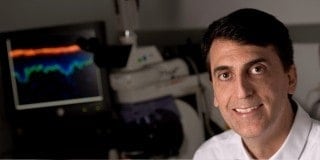Researchers have identified a previously unknown oncogene that drives the development of a common human skin cancer in response to exposure to sunlight.
A genetic mutation caused by ultraviolet light is likely the driving force behind millions of human skin cancers, according to researchers at the Stanford University School of Medicine.
The mutation occurs in a gene called KNSTRN, which is involved in helping cells divide their DNA equally during cell division.
Genes that cause cancer when mutated are known as oncogenes. Although KNSTRN hasn’t been previously implicated as a cause of human cancers, the research suggests it may be one of the most commonly mutated oncogenes in the world.
“This previously unknown oncogene is activated by sunlight and drives the development of cutaneous squamous cell carcinomas,” said Paul Khavari, MD, PhD, the Carl J. Herzog Professor in Dermatology in the School of Medicine and chair of the Department of Dermatology. “Our research shows that skin cancers arise differently from other cancers, and that a single mutation can cause genomic catastrophe.”
Cutaneous squamous cell carcinoma is the second most common cancer in humans. More than 1 million new cases are diagnosed globally each year. The researchers found that a particular region of KNSTRN is mutated in about 20 percent of cutaneous squamous cell carcinomas and in about 5 percent of melanomas.
A paper describing the research was published online Sept. 7 in Nature Genetics. Khavari, who is also a member of the Stanford Cancer Institute and chief of the dermatology service at the Veterans Affairs Palo Alto Health Care System, is the senior author of the paper. Postdoctoral scholar Carolyn Lee, MD, PhD, is the lead author.
A surprise
Lee and Khavari made the discovery while investigating the genetic causes of cutaneous squamous cell carcinoma. They compared the DNA sequences of genes from the tumor cells with those of normal skin and looked for mutations that occurred only in the tumors. They found 336 candidate genes for further study, including some familiar culprits. The top two most commonly mutated genes were CDKN2A and TP53, which were already known to be associated with squamous cell carcinoma.
The third most commonly mutated gene, KNSTRN, was a surprise. It encodes a protein that helps to form the kinetochore — a structure that serves as a kind of handle used to pull pairs of newly replicated chromosomes to either end of the cell during cell division. Sequestering the DNA at either end of the cell allows the cell to split along the middle to form two daughter cells, each with the proper complement of chromosomes.
If the chromosomes don’t separate correctly, the daughter cells will have abnormal amounts of DNA. These cells with extra or missing chromosomes are known as aneuploid, and they are often severely dysfunctional. They tend to misread cellular cues and to behave erratically. Aneuploidy is a critical early step toward the development of many types of cancer.
A dangerous swap
The mutation in the KNSTRN gene was caused by the replacement of a single nucleotide, called a cytosine, with another, called a thymine, within a specific, short stretch of DNA. The swap is indicative of a cell’s attempt to repair damage from high-energy ultraviolet rays, such as those found in sunlight.
“Mutations at this UV hotspot are not found in any of the other cancers we investigated,” said Khavari. “They occur only in skin cancers.”
The researchers found the UV-induced KNSTRN mutation in about 20 percent of actinic keratoses — a premalignant skin condition that often progresses to squamous cell carcinoma — but never in 122 samples of normal skin, indicating the mutation is likely to be an early event in the development of squamous cell carcinomas.
Furthermore, overexpression of mutant KNSTRN in laboratory-grown human skin cells disrupted their ability to segregate their DNA during cell division and enhanced the growth of cancer cells in a mouse model of squamous cell carcinoma.
Finally, Lee compared five patient-derived squamous cell carcinomas that had the KNSTRN mutation with five samples that did not have the mutation. Although both sets of cells were aneuploid, those with the mutation had the most severely abnormal genomes.
he identification of a new oncogene will allow researchers to better understand how these types of skin cancers develop. It may also give them clues about how to develop new therapies for the disease. In this case, it also neatly connects the dots between sun exposure and skin cancer.
“Essentially, one ultraviolet-mediated mutation in this region promotes aneuploidy and subsequent tumorigenesis,” said Khavari. “It is critical to protect the skin from the sun.”
Other Stanford co-authors of the study are graduate students Aparna Bhaduri and Whitney Johnson; research assistant Angela Mah; postdoctoral scholars Alexander Ungewickell, PhD, and Eon Rios, PhD; former undergraduate student Cody Aros; undergraduate student Christie Nguyen; senior research scientist Zurab Siprashvili, PhD; associate professor of biochemistry Aaron Straight, PhD; assistant professor of pathology and of dermatology Jinah Kim, MD; and clinical professor of dermatology Sumaira Aasi, MD.
The research was supported by the National Institutes of Health (grant AR43799) and the U.S. Veterans Affairs Office of Research and Development.
Information about Stanford’s Department of Dermatology, which also supported the work, is available at http://dermatology.stanford.edu.


